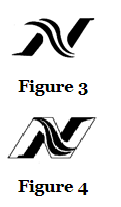The US corporation New Balance is one of the world's biggest sports shoe manufacturers, known mostly for its high-quality, high-performance trainers featuring the iconic 'N' logo.
In 1983 New Balance registered a representation of its logo (Figure 1) for goods in Class 25 with the China Trademark Office.
In 2014 it registered another representation of the logo (Figure 2), also in Class 25.
Shortly after obtaining its first registration, New Balance began to encounter many imitators using the letter 'N' on the side of their trainers. The defendants challenged the similarity between their use of the letter on their shoes and New Balance's use of the trademark that it had registered in 1983. New Balance replied by citing Article 5 of the Anti-unfair Competition Law 1993, which protects trade dress (ie, the unique decoration of a well-known product). The Hangzhou Intermediate Court, the Shanghai Huangpu District Court and the Shanghai Second Intermediate Court recognised that New Balance's use of the 'N' logo on both sides of its trainers constituted the peculiar trade dress of well-known goods and ruled in its favour in judgments dated April 13 2006, April 23 2012 and December 28 2012, respectively.
In 2010 Hainan Qierte Investment LLC filed applications to register two trademarks (Figures 3 and 4) in Class 25. The registrations were granted in 2012.
Both marks were subsequently assigned to another company, Qierte Co, Ltd, in 2013.
On January 7 2014 New Balance brought an invalidation action against the two disputed marks (Figures 3 and 4) before the Trademark Review and Adjudication Board (TRAB), citing Article 28 (similar marks on similar goods), Article 31 (causing harm to another party's prior right) and Article 13 (well-known trademarks) of the Trademark Law 2001. New Balance also referred to the Anti-unfair Competition Law.
On March 31 2015 the TRAB ruled against New Balance, finding that:
- the disputed marks were not similar to the cited marks (Figures 1 and 2);
- New Balance's use of the 'N' logo did not constitute the unique decoration of well-known goods (ie, trade dress); and
- the evidence adduced by New Balance had been insufficient to prove that the cited marks had become well-known before the disputed marks' application dates.
New Balance appealed the decision before the Beijing IP Court. On May 10 2016 the court ruled in New Balance's favour, finding that:
- the use of the disputed marks was likely to cause confusion, considering the similarity between the signs and the reputation of the cited marks; and
- the evidence produced by Qierte had failed to prove that the disputed marks had become distinguishable from the cited marks through their use.
As the court found that the registration of the disputed marks had violated Article 28 of the Trademark Law, it held that there was no need to examine the plaintiff's argument regarding trade dress.
Qierte and the TRAB filed an appeal with the Beijing High Court.
On October 25 2016 the Beijing High Court quashed the first-instance judgment on the basis that:
- there were major differences between the disputed marks and the cited marks in terms of overall visual effect, composition and design style; and
- the evidence on file was insufficient to prove that New Balance's 'N' logo had constituted the peculiar trade dress of well-known goods before the filing date of the disputed marks.
On April 21 2017 New Balance applied to the Supreme People's Court for a retrial.
Supreme People's Court decision
In its retrial application, New Balance:
- cited the prior court judgments which had found that the 'N' which New Balance used on its sneakers constituted the unique decoration of well-known goods. It thus claimed that the Beijing High Court had contravened such established findings and erred in its application of the law, which was adverse to the creation of stable jurisprudence;
- showcased how commercial signs are customarily included on sports shoes;
- emphasised Qierte's bad faith through its imitation of New Balance and argued that, when assessing the likelihood of confusion between two marks, the courts should consider all of the facts of the case, including the disputed trademark registrant's bad faith; and
- produced evidence of actual confusion in the market.
In September 2017 the Supreme People's Court formally accepted New Balance's application for a retrial on the ground of possible improper application of the law. The retrial is now pending.
As the Supreme People's Court did not elaborate on the argument of an improper application of the law, it is difficult to speculate on the intentions behind its decision.
The Supreme People's Court may see this case as a good opportunity to apply the new direction taken in its Interpretation of the Revised Trademark Law 2017 regarding how courts should assess the likelihood of confusion. The court's prior practice was to:
- compare trademarks, regardless of the case's context; and
- determine whether they were similar and hence whether there was a likelihood of confusion.
The new method, which the court clearly wishes to be applied in all types of case, is to look at the big picture and consider, among other things:
- the level of similarity between the marks;
- the level of reputation acquired by the prior trademark; and
- the good or bad faith of the latter trademark applicant or user.
Another possible explanation is that the Supreme People's Court considers that the TRAB and the Beijing High Court erred when they ignored the prior judgments affirming the protection of trade dress.
This article was first published by the International Law Office, a premium online legal update service for major companies and law firms worldwide. Register for a free subscription.






